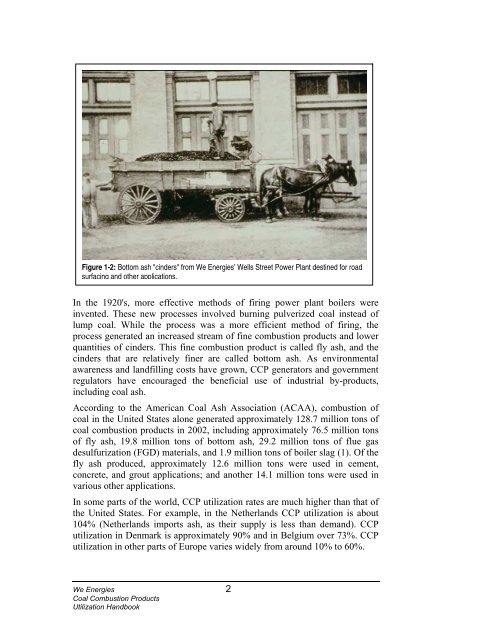- Page 1 and 2: Ramme - Tharaniyil Second Edition A
- Page 3 and 4: This book is dedicated to all the i
- Page 5 and 6: Contents Chapter 5 Controlled Low-S
- Page 7 and 8: Contents Appendix A Product Data Sh
- Page 9: Chapter 1 Background and History o
- Page 13 and 14: are currently installed on about 25
- Page 15 and 16: problems. In the late 1920’s, cin
- Page 17 and 18: Chapter 2 CCPs and Electric Power
- Page 19 and 20: for loading dry bulk semi tankers o
- Page 21 and 22: Figure 2-2: Basic Diagram of an IGC
- Page 23 and 24: Properties of Fly Ash Fly ash is a
- Page 25 and 26: for air entraining admixtures, maki
- Page 27 and 28: Fly ash is an artificial pozzolan.
- Page 29 and 30: Table 2-6: Geotechnical Properties
- Page 31 and 32: Table 2-9 shows the chemical compos
- Page 33 and 34: Table 2-12: Typical Chemical Compos
- Page 35 and 36: The following coal fired power plan
- Page 37 and 38: All bottom ash is removed as necess
- Page 39 and 40: ottom ash is removed by a hydraulic
- Page 41 and 42: Chapter 3 Properties of We Energie
- Page 43 and 44: that distribute and test fly ash to
- Page 45 and 46: Physical, Chemical and Mechanical P
- Page 47 and 48: However, some engineering propertie
- Page 49 and 50: ----------------------------U.S. ST
- Page 51 and 52: Results of Testing to AASHTO Standa
- Page 53 and 54: Table 3-8: Summary of We Energies B
- Page 55 and 56: Chapter 4 Concrete and Concrete Ma
- Page 57 and 58: alumina in the pozzolan may also re
- Page 59 and 60: Dunstan summarized his work in term
- Page 61 and 62:
The level of shrinkage strains depe
- Page 63 and 64:
strength tests were performed at va
- Page 65 and 66:
Discussion of Test Results - 4,000
- Page 67 and 68:
Other important observations from t
- Page 69 and 70:
Figure 4-3: Compressive Strength vs
- Page 71 and 72:
300 290 AMOUNT OF WATER, lbs 280 27
- Page 73 and 74:
Table 4-8: PPPP ASTM C618 Class C F
- Page 75 and 76:
The final setting time for 5000 psi
- Page 77 and 78:
Table 4-12: Length Change* NON-AIR-
- Page 79 and 80:
Table 4-14: Freeze-Thaw Tests* (Air
- Page 81 and 82:
Abrasion resistance tests were perf
- Page 83 and 84:
Table 4-16: Compressive Strength Te
- Page 85 and 86:
4 DEPTH OF WEAR, mm @ 60 Minutes 3.
- Page 87 and 88:
Table 4-19: Mixture Proportions Usi
- Page 89 and 90:
12000 COMPRESSIVE STRENGTH, PSI 100
- Page 91 and 92:
Table 4-21: Air Permeability Test R
- Page 93 and 94:
Table 4-22: Water Permeability Test
- Page 95 and 96:
Table 4-23: Chloride Permeability T
- Page 97 and 98:
Tax Incremental Financing (TIF) was
- Page 99 and 100:
Figure 4-20 : Maple Avenue roadway
- Page 101 and 102:
Figure 4-22: Finishing touch to We
- Page 103 and 104:
Table 4-26: Concrete Mixture and Si
- Page 105 and 106:
6. The high-volume Class C fly ash
- Page 107 and 108:
Table 4-31: Average Tensile Strengt
- Page 109 and 110:
Table 4-35: Changes in Ultrasonic P
- Page 111 and 112:
Table 4-38: Results of De-Icing Sal
- Page 113 and 114:
Table 4-40: Abrasion Resistance of
- Page 115 and 116:
Summary Based on the data recorded
- Page 117 and 118:
3.00 M 101.5 MM WRAPPED UNDERDRAIN
- Page 119 and 120:
mixture and concrete mixture. Also,
- Page 121 and 122:
Testing Program The testing program
- Page 123 and 124:
Test Results Table 4-46 shows the c
- Page 125 and 126:
Fly Ash Concrete for Precast/Prestr
- Page 127 and 128:
Table 4-49: Concrete Mixture Propor
- Page 129 and 130:
Figure 4-27: Electrical Resistance
- Page 131 and 132:
Table 4-51: Electrical Properties o
- Page 133 and 134:
fly ash by weight of total cementit
- Page 135 and 136:
Table 4-53: Compressive Strength of
- Page 137 and 138:
Chapter 5 Controlled Low-Strength
- Page 139 and 140:
Table 5-1: Mixture Proportions and
- Page 141 and 142:
1800 COMPRESSIVE STRENGTH, psi 1600
- Page 143 and 144:
Table 5-3: Chemical and Fineness Te
- Page 145 and 146:
1800 COMPRESSIVE STRENGTH, psi 1600
- Page 147 and 148:
and corresponding compressive stren
- Page 149 and 150:
conductivity tests were conducted u
- Page 151 and 152:
It can be concluded from this resea
- Page 153 and 154:
Table 5-13: Compressive Strength of
- Page 155 and 156:
(4) Compatible with copper, aluminu
- Page 157 and 158:
Mechanical Properties The compressi
- Page 159 and 160:
Figure 5-10: Electrical permeabilit
- Page 161 and 162:
Pilot Projects Using We Energies CL
- Page 163 and 164:
WisDOT Low Permeability CLSM with W
- Page 165 and 166:
material for foundations, changing
- Page 167 and 168:
Chapter 6 Commercial Applications
- Page 169 and 170:
The report also evaluated frost sus
- Page 171 and 172:
Field Study Following the initial s
- Page 173 and 174:
Figure 6-3: Bottom ash base course
- Page 175 and 176:
Table 6-2: Permeability and Drainag
- Page 177 and 178:
Bottom Ash as an Aggregate in Aspha
- Page 179 and 180:
Table 6-4: Total Elemental Analysis
- Page 181 and 182:
We Energies Bottom Ash as a Soil In
- Page 183 and 184:
The coal combustion materials landf
- Page 185 and 186:
The only other compounds detected t
- Page 187 and 188:
affect combustion. The resulting fl
- Page 189 and 190:
Table 6-7: Dry-Cast Concrete Block
- Page 191 and 192:
Table 6-10 Compressive Strength of
- Page 193 and 194:
Chapter 7 Fly Ash Stabilized Cold
- Page 195 and 196:
Using the back-calculated SN values
- Page 197 and 198:
Falling Weight Deflectometer tests
- Page 199 and 200:
unconfined compressive strength of
- Page 201 and 202:
Chapter 8 Fly Ash Metal Matrix Com
- Page 203 and 204:
The green density of the aluminum f
- Page 205 and 206:
Table 8-1: Alloy Samples Tested in
- Page 207 and 208:
Cenospheres Cenospheres are hollow,
- Page 209 and 210:
Chapter 9 Environmental Considerat
- Page 211 and 212:
judgment is required for new applic
- Page 213 and 214:
Table 9-2: NR 538 Fly Ash Analysis
- Page 215 and 216:
Table 9-3: NR 538 Fly Ash Analysis
- Page 217 and 218:
Table 9-4: NR 538 Bottom Ash Analys
- Page 219 and 220:
Table 9-5: NR 538 Bottom Ash Analys
- Page 221 and 222:
Table 9-7: ASTM D3987 Extraction An
- Page 223 and 224:
Table 9-8: Typical Heavy Metals Fou
- Page 225 and 226:
The voluntary C 2 P 2 Challenge Pro
- Page 227 and 228:
General Usage - NR 538 Applicabilit
- Page 229 and 230:
* Use Property Owner Notification -
- Page 231 and 232:
Mercury Removal-Ash Beneficiation (
- Page 233 and 234:
the air slide inlet was set at 538
- Page 235 and 236:
equired removal temperatures of 813
- Page 237 and 238:
Chapter 10 Minergy LWA - Structura
- Page 239 and 240:
Chapter 11 Sample Specifications
- Page 241 and 242:
Part 2 - Products 2.01 Concrete Mat
- Page 243 and 244:
3.02 Embedded Items A. All sleeves,
- Page 245 and 246:
C. Provide adequate number of units
- Page 247 and 248:
B. Reinforce or replace deficient w
- Page 249 and 250:
show the strength of masonry strong
- Page 251 and 252:
3.02 Bottom Ash Placing and Compact
- Page 253 and 254:
3. The CLSM shall meet the followin
- Page 255 and 256:
3.02 CLSM Depositing A. CLSM shall
- Page 257 and 258:
11.5 Sample Specification for We En
- Page 259 and 260:
D. Basis of Payment This item, meas
- Page 261 and 262:
If the reprocessed asphaltic base-f
- Page 263 and 264:
Chapter 12 References 1. American
- Page 265 and 266:
33. University of Wisconsin-Milwauk
- Page 267 and 268:
69. Naik, T.R., Kraus, R.N., and Si
- Page 269 and 270:
Appendix A Product Data Sheets Min
- Page 271 and 272:
Personal Protective Equipment Speci
- Page 273 and 274:
FirstAid Eyes Inhalation Ingestion
- Page 275 and 276:
Appendix B Radioactivity in Coal a
- Page 277 and 278:
annual number of curies of each of
- Page 279 and 280:
is divided among cosmic (30 mrem),
- Page 281 and 282:
constructed with fly ash building m
- Page 283 and 284:
Appendix C Field Guide for Recycli
- Page 285 and 286:
‣ Blend the fly ash and prepared
- Page 287 and 288:
Index AASHTO See American Associati
- Page 289 and 290:
Index Backfill material, 6, 43, 138
- Page 291 and 292:
Index Disposal costs, 5 See also La
- Page 293 and 294:
Index Pavement, 26, 109, 187; botto
- Page 295 and 296:
Index Size, boiler slag, 22; bottom
- Page 297:
About the Authors Bruce W. Ramme B



